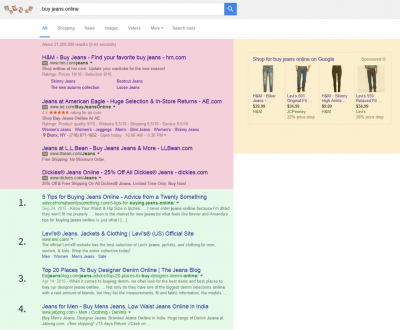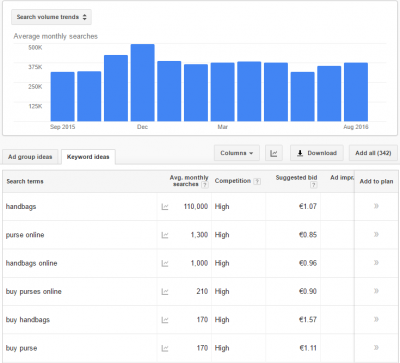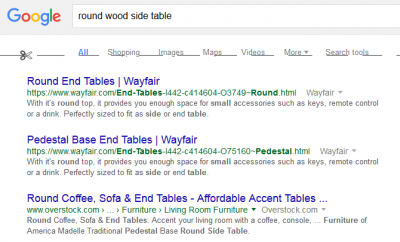A higher Google ranking? Choose the right keywords for your online store!


You probably know the feeling… You set out to launch your online store with great enthusiasm, but you forgot one crucial detail… how will customers find you? SEO may not be the first thing you think about when you launch an online store, but it is extremely important. Discover the basics of SEO in three posts, starting with this one. Enjoy!
SEO stands for Search Engine Optimization. Doesn’t ring a bell? No worries, have a seat and get ready to explore this fascinating topic!
Let’s kick off by explaining a few important concepts:
Search Engine Optimization (SEO): everything you do to boost the position of your online store in search engines, such as Google.
On-page SEO: the steps you can take yourself to improve your site or online store, such as writing catchy content, using nice images, etc. This will be discussed in the second post.
Off-page SEO: this is done outside your own website and mainly includes searching for links to your online store. This will be discussed in the third article.
Keywords: words you think people will use to find your products in search engines and words you want people to associate with your website or store (this is called ‘ranking’)
What makes SEO so important?
A lot of people use search engines as a starting point when shopping online. According to comScore, Google approaches a 65% market share in the US. So, it comes as no surprise that your position in the Google ranking can make or break your online store. In 2014, Advanced Web Ranking analyzed the impact of various rankings on Google searches. Simply put, they assessed the traffic that each position in Google generates.
Be honest, do you often go beyond the fifth result? Probably not, and you’re not alone. On average, the top-5 positions in Google account for 67.6% of all traffic. About 23% of visitors click on an AdWords ad and the remaining 10% scroll down to the pages listed lower in the ranking.

The image above shows AdWords campaigns marked red. As part of these campaigns, advertisers pay for their page to be displayed here. Google Shopping, Google’s very own shopping portal, is highlighted yellow. Finally, the organic (free) search results are marked green. That is what we’ll be focusing on in this post.
In a nutshell, if you sell products that people tend to search for in Google, you need to secure a high ranking in this search engine. If you top the search results, you’ll get 30% of all visitor traffic. And best of all? It’s entirely free!
The key to success? Keywords!
There’s no such thing as SEO without keywords. You need to know what potential customers are looking for. The first step to a better Google ranking is to draw up a list of the right keywords.
For online stores, the products on offer are generally the main keywords, often combined with other words, such as:
- handbags
- buy handbag
- leather handbag
- black leather handbag
As you can see, there is a difference between a keyword for a category page, such as ‘handbags’, and a keyword for a product page, such as ‘black leather handbag’. To clarify, a category page features a collection of various similar products, while a product page features one specific product.
OK, so far, so good. But it takes more than a list of product-related keywords to make the cut. If you want to secure a good spot in Google, you’re in for some serious competition, so you need to make smart choices!

With a high Google ranking you can secure up to 30% of all search traffic!
Smart choices
Which keywords you choose depends on three factors – search volume, competition and search intention.
- Search volume: the number of searches for a specific keyword.
- Competition: the number of competing pages that are looking to achieve a high ranking based on the same keyword.
- Search intent: the Google user’s intended goal, e.g. gather information, compare or buy.
Ideally, your keyword will have a high search volume and little competition, and people will search for it with the intention to buy. Unfortunately, in practice things are not that straightforward – the more ‘generic’ the keyword, the higher the number of searches and the greater the competition.
Another key rule is the more targeted (specific, not generic) the keyword, the higher the chance of conversion (willingness to buy). Someone looking for ‘Nike sneakers’ or a ‘white woolen carpet’ will be more inclined to buy than someone searching ‘buy sneakers’ or simply ‘carpets’.
Have a look at the fictional example below:

The two keywords above result in many more views. Yet a high ranking for ‘oozoo ladies watches’ and ‘oozoo ladies watches pink’ results in virtually the same conversion rate, namely 31 versus 41. And it’s much easier to achieve too!
How to choose your keywords
Now that you know the basic ins and outs, it’s time for you to choose your keywords! A handy tool is Google’s Keyword Planner. Activate AdWords in your Google account to use this tool free of charge.
- Open the Keyword Planner and enter the keywords for a specific product or category that you think people tend to search for.
- Under country, select ‘United States’, under language ‘English’ and under network, ‘Google’ if you’d like to focus on the US market.
- Click on ‘Get ideas’.
Once the tool has finished processing your request, go to the tab ‘Keyword ideas’. At the top you’ll see the keywords you’ve entered.

The columns ‘Competition’ and ‘Suggested bid’ give you an indication of the competition you can expect for each keyword.
In the second table you’ll find Google’s own keyword suggestions. If they prove very different from the ones you entered yourself, click on ‘Keyword options’ in the menu on the left-hand side and select ‘Show broadly related ideas’. A new list with keyword suggestions will then be displayed.
These suggestions will help you to quickly find suitable keywords. When entering and choosing keywords make sure that:
- your competition and suggested bid are not too high. As a guideline, we suggest you enter a maximum of € 0.50.
- you choose the right spelling and word order: ‘ladies’ watch’ or ‘watch ladies’, ‘handbags leather’ or ‘leather handbags’. Always try different combinations to see which ones are the most searched-for.
Go through this process for every product group to determine your category keywords. A few examples:
- Category keyword: ladies handbags
- Subcategory keywords: michael kors handbags, fab handbags, leather handbags, etc.
Also choose keywords for your product pages. Stick to one strategy per product group. Let’s take the product group ‘handbags’ as an example:
- Product ‘Fab Bag Small’: fab bag small
- Product ‘Vans SK8 sneakers high’: buy vans sk8 sneakers
Adding a conversion keyword , such as ‘buy’, can be useful because it boosts both findability and the chance of conversion. Take the last example, ‘vans sk8 sneakers’. Your store can be found both using the keywords ‘buy sk8 sneakers’ and ‘vans sk8 sneakers’.
Check your keywords
Last but not least, you should know that the ‘Competition’ feature in the Keyword Planner refers to your competitors who have paid to be displayed in the search results (via AdWords). It does not refer to the (free) organic results. So always enter your keywords in Google yourself for your main pages, to check whether your competition for organic results matches that displayed in the Keyword Planner.
Below you will find an example where the Keyword Planner indicated high competition for the keywords ‘round wood side table’. However, if we have a look in Google, we see this combination of keywords only appears on one page in the top-3 results. That makes it an excellent keyword combination!

Keywords form the basis for all your future SEO efforts, so do your research to ensure a high Google ranking. Next week you’ll discover how to use the chosen keywords on your website. Stay tuned!
Other items from this series:
- A higher Google ranking? SEO is your answer!
